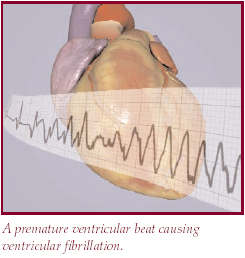Sudden cardiac death (SCD), also called cardiac arrest, is used to describe a situation in which the heart abruptly and without warning stops working, so no blood can be pumped to the rest of the body. It is responsible for half of all heart disease deaths.
Sudden cardiac death occurs when the heart’s electrical system malfunctions. It is not a heart attack (also known as a myocardial infarction). A heart attack occurs when a blockage in a blood vessel interrupts the flow of oxygen-rich blood to the heart, causing heart muscle to die.
The most common cause of SCD is a heart rhythm disorder (arrhythmia) called ventricular fibrillation (VF).
Your heart has a built-in electrical system. In a healthy heart, a “pacemaker” triggers the heartbeat, with electrical impulses to run along pathways in the heart and causing it to contract in a regular, rhythmic way. When contractions happen, blood is pumped through your heart.
During ventricular fibrillation, the electrical signals suddenly become very rapid and chaotic. As a result, the your heart begins to quiver (fibrillate) instead of contract and no longer pumps blood to the rest of your body. If blood does not flow to your brain, it becomes starved of oxygen, and you quickly lose consciousness. Unless an emergency shock is delivered to your heart to restore its regular rhythm, death can occur within minutes. It’s estimated that more than 70% of ventricular fibrillation victims die before reaching the hospital.
SCD often occurs in active, outwardly healthy people with no known heart disease or other health problems.
There are numerous contributors to cardiac arrest, but two of the most important ones are:
- A previous heart attack: 75% of the people who die of SCD show signs of a previous heart attack.
- Coronary artery disease: 80% of SCD’s victims have signs of coronary artery disease.
There are also a number of symptoms and signs that may indicate that a person is at increased risk for SCD. These include:
- An abnormal heart rate or rhythm (arrhythmia) of unknown cause
- An unusually rapid heart rate (tachycardia) that comes and goes, even when the person is at rest
- Episodes of fainting (called syncope) of unknown cause
- A low ejection fraction (EF): The ejection fraction is a measurement of how much blood is pumped by the ventricles with each heart beat. A healthy heart pumps 55% or more of its blood with each beat. People at highest risk for SCD have ejection fractions of less than 40%, combined with ventricular tachycardia, an abnormally fast heart rate in the lower chambers of the heart.
There are a number of tests that can be performed to determine if someone is in a group that is at high risk for cardiac arrest. These include:
- Cardiac ECHO,
- EKG,
- Holter monitor,
- Event recorder. Unlike a holter monitor, it does not operate continuously. Instead, patients turn on the device whenever they feel their heart beating too quickly or chaotically,
- Electrophysiology study (EPS) – This test is performed at a hospital or clinic. A specialized cardiologist (electro physiologist) studies the speed and flow of electrical signals through the heart, identifies rhythm problems and pinpoints areas in the heart that may be the sources of abnormal electrical signals that trigger arrhythmias. This information can help determine whether the patient is in a group at higher risk for SCD.
There are a number of things people can do to decrease the likelihood of becoming a victim of sudden cardiac death. To begin with, living a “heart healthy” life can help reduce the chances of dying of cardiac arrest or other heart conditions. This includes exercising regularly, eating healthful foods, maintaining a reasonable weight and avoiding smoking. Treating and monitoring diseases and conditions that can contribute to heart problems, including high blood pressure, high cholesterol and diabetes, is also important.
Finally, for some patients, preventing sudden cardiac death means controlling or stopping the abnormal heart rhythms that may trigger ventricular fibrillation. Treating arrhythmias is done in three ways:
- Medications including ACE inhibitors, beta blockers, calcium channel blockers and other antiarrhythmics, can control abnormal heart rhythms or treat other conditions that may contribute to heart disease or SCD. Taking medication alone has not proved to be very effective in reducing cardiac arrest. These medications are sometimes taken by patients who also have an ICD, in order to reduce how often it fires.
- Implantable cardioverter defibrillators (ICDs) have been very successful in preventing sudden cardiac death in certain high-risk patients. Like a pacemaker, ICDs are implanted under the skin. Wires called leads run from the ICD to the heart, and the device monitors the heart to detect any abnormal rhythms. If a dangerous arrhythmia is detected, the ICD delivers an electrical shock to restore the heart’s normal rhythm and prevent sudden cardiac death. The ICD can also act like a pacemaker if the heart is beating too slowly.
- Catheter Ablation, radiofrequency energy (heat), cryotherapy (freezing), or other energy forms are used to destroy small areas of heart muscle that give rise to the abnormal electrical signals that cause rapid or irregular heart rhythms. The energy is delivered through catheters that are snaked through the veins or arteries to the heart. Catheter ablation is sometimes done in patients who have an ICD to decrease the frequency of abnormal heart rhythms, and again, to reduce how often the device fires.
(From: http://www.hrspatients.org/patients/heart_disorders/cardiac_arrest/default.asp)


Comments 2
Pingback: Bundle Branch Block | Cardiac Health
Pingback: What is QTc and Long QT syndrome (LQTS)? | Cardiac Health